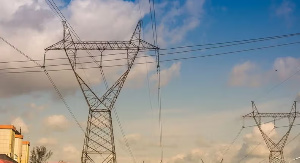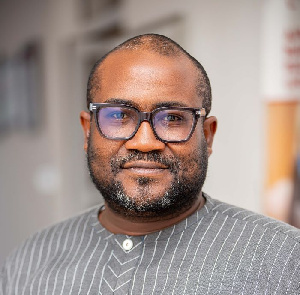- Home - News
- Polls
- Year In Review
- News Archive
- Crime & Punishment
- Politics
- Regional
- Editorial
- Health
- Ghanaians Abroad
- Tabloid
- Africa
- Religion
- Election 2020
- Coronavirus
- Photo Archives
- News Headlines
- Press Release
General News of Thursday, 20 April 2000
Source: null
A Nigerians View of Ghana
Ghana Was Not Named Gold Coast For Nothing
By Bamidele Johnson Tempo (Lagos)
Lagos - Having been weaned on the 'giant of Africa' myth, nothing in my shallow imagination suggested to me that there is no city as enchanting as Lagos, nor is there any country like Nigeria, on the African continent.
Living in Lagos and Nigeria, with an undisguised air of superficial affluence, left in my mind, the idea that I'm an inhabitant of one of the world's most modern cities in the league of London, Paris, and New York. It, however, took less than six hours of staying in Accra, Ghana, for the idea to recede.
After a hectic 10-hour trip from Lagos, I arrived Accra at about 9.30 pm (10.30 pm Nigerian time). The lateness of my arrival ensured that I saw nothing more than a few dainty buildings as I was driven through largely dark streets to the University of Ghana, Legon.
Yet, the little I was able to see suggested to me that there was more 'gold' other than the one in that nation's famous goldfields at Obuasi. The next morning, Accra threw itself at my face as I flipped, losing my foolish nationalistic pride, and, desired to see more of Ghana.
Despite being the commercial and political artery of Ghana, Accra is a sedate, somewhat idyllic city. It resembles a sprawling blanket of old and modern buildings on streets connected by an impressive mosaic of smooth, multi-lane highways with ample sidewalks.
Traffic jams, at least the asphyxiating Lagos variant, are uncommon.
Policemen, directing traffic, are rare sight except at roundabouts. The traffic is controlled by lights which all drivers obey diligently. Even commercial bus and taxi drivers exhibit that trait of obedience. I immediately came to the conclusion that Ghanaians are an orderly people.
Nothing shook that belief till I left one week later. Not only in Accra, everywhere I visited in Ghana, I saw clean taxi cabs and buses. I never once saw a decrepit car. Bernard Kuffour, a taxi driver, however told me that there are wretched cabs but the drivers dare not bring them out to the urban centres as nobody would step into them where they have options of surfeit of clean Daewoo Tico, Hyundai Excel and numerous models of Toyota and other Japanese cars running the streets. Cars are cheap and I suspect it is one reason why Ghanaians could pick and choose.
For an urban centre, Accra's crime-rate and that of the whole country is incredibly low. It is almost as safe to walk around at night as it is in daytime. There are no fears of muggers pouncing on you. Armed policemen are hardly seen in public. Most of the roads are also well lit at night.
Also, Ghanaians seem to have imbibed so much of middle class habits. Phones are so much available, via booths, that there are no long queues wherever you find them. Most interesting too are cell phones which are almost as common as artificial limbs in Angola. Taxi drivers, lecturers and civil servants carry them. In fact, Ghanaians are a cell-phone- totting lot. On the campus of the University of Legon, four out of every 10 students carry cell phones. Conservatively put, that is. I was reliably informed that it costs less than N10,000 to get a mobile phone. This amount takes care of the connection fee.
Also there are no exorbitant bills. A user only needs to buy a card for his phone, depending on the type of set. A card costs about N5,000. With a N2,500 card, you can speak with somebody in Europe for five minutes. The same amount would take care of a 25-minute call to Nigeria. Getting through to Nigeria is, however, a difficult thing.
In a way, Ghanaians seem to consume less alcohol than Nigerians. That perhaps explains why there isn't a preponderance of watering holes as we have in Nigerian cities. The most popular brews are ABC beer, Club (which comes in big and small bottles), Gulder, Star and Guinness. Make the mistake of asking for stout and you could be in for a long wait to have a drink.
Ghanaians call it Guinness (there are other brands of stout).
The relative disinterest in alcohol consumption is taken care of by food.
Ghanaians seem to take their feeding seriously. The menu includes kenke the country's staple, fufu (slightly different from the Nigerian version) and banku. These are eaten with a variety of soups which include okro, palm nut soup and palaver soup (egusi).
Many families, I was told, do not cook but buy from food vendors outside. Perhaps due to force of habit, chauvinism or both, I maintained a safe distance from Ghanaian food and stuck to fried rice chicken and salad, which cost between 8,000 to 12,000 cedis, depending on where you eat.
One thing that almost impeded my sanity was the copious amount of money Ghanaians need for any transaction. My first taxi trip cost 4,000 cedis and I almost clashed with the driver for charging such outrageous amount. Almost every item is in the thousand range. A packet of Rothmans cigarettes cost 4,500 cedis as well as a small bottle of Guinness stout. I never managed to work out how people move around with such huge cash. The value of the currency is very low, exchanging at 40 cedis to a naira.
What I missed by not eating Ghanaian dishes, if any, I was compensated for by electricity, which never once blinked, and uninterrupted water supply everywhere I went. I had almost forgotten what it is like to use a shower.
For one whole week, I had the fortune of taking a leave from bathing, using a bowl to scoop water from a bucket. I was simply awestruck that Ghanaians take such things for granted while citizens of the 'giant of Africa' would have dashed to the churches for thanksgiving.
During my stay, I visited three of the country's five universities: the University of Ghana, Legon, The Kwame Nkrumah University of Technology in Kumasi and the University of Cape Coast.
The University of Ghana, which I'm more familiar with, is a very good example of proper preservation. The buildings are almost as good as new. The students population is moderate such that the facilities do not get overstretched. I ran into a couple of Nigerians schooling in Legon and they have the benefit of not having to contend with frequent campus closures back home.
Campus cults are non-existent. In fact, manners seem to tilt towards the British tradition of 'gentlemanliness'. The campus is not as noisy as the average Nigerian university campus. Alcohol and cigarettes are not sold just anywhere on campus. I noticed that I did not run into any students smoking outside the designated places on campus as Ghanaians seem to have a fetish for compliance.
In Accra, I also visited the Kwame Nkrumah Circle (one of the many sumptuous roundabouts in the city, Ghanaians call them 'circles'), Ring Road and the Kwame Nkrumah Mausoleum. What I saw of Accra whetted my appetite as I longed to see more of Ghana.
So off to Kakum I went . Kakum is located in Ghana's rain forest belt and is home of Kakum National Park which I hadn't heard of but learnt is very famous outside Ghana. Like most infrastructure in Ghana, the Kakum National Park is well kept. Information at the park house says the park is located in a 360 kilometre blanket of the tropical rain forest.
Kakum park is refuge for such globally endangered species as the forest elephant, bongo and yellow backed ducker. It also houses 300 bird species, over 100 mammals, reptiles and amphibians as well as a quarter of a million insects, including 600 butterfly species.
Courteous park staff took visitors around and a notable feature of the park is a 350-feet hair-raising canopy walk. The canopy is constructed like a hammock, swinging over a 50-feet vegetation filled gorge. Most visitors took the canopy walk, albeit with their hearts in their mouths. I had to turn back because, I found the experience unappealing.
After seeing a little of Ghana's present, my tour threw me way back into the country's past. I had a feel of Ghana's past in Cape Coast, Edina and Kumasi, Cape Coast and Edina (Elmina) are world famous sites of two monstrously huge castles, built and used by European slave traders for their obnoxious exports.
Located beside by the sea, Cape Coast and Elmina Castle throw visitors back, effortlessly, into the days of the slave trade. Spooky tunnels, dungeons and holes inside which slaves were kept before export, serve as grim reminders of the evil trade. Scores of visitors pour in daily. At Elmina, most parts of the huge castle are kept in their original forms.
It is difficult not to be touched by the magnitude of bestiality the slave masters perpetrated in the castle . One Afro-American visitor was so shaken that she sobbed and discontinued the castle tour.
There are also manacles and chains that accentuated the grimness the castles. The Elmina and Cape Coast castle are just two of 30 such castles which have become veritable sources of foreign exchange for Ghana.
Kumasi was my next port of call. It is the second most important Ghanaian city and the capital of the Ashanti region, domain of the world famous Asantehenes and their immodestly opulent courts. Kumasi is also home to the famous Ashanti Kotoko soccer team, a giant in African football.
Kumasi hasn't the swish of Accra. It is more like the Ghanaian version of Ibadan. Still, the characteristic Ghanaian orderliness is evident. What Kumasi lacks in style, it makes up for in culture. Ashantis are without doubt Ghana most culturally advanced people.
Theirs is the most revered kingship in Ghana. Ashantis respect their king and describe him in superlative terms. The splendour of the king's court is legendary. When he walks, I gathered, two men hold his arms one on each arm, because of the weight of the gold which adorns his arms.
Kumasi offers so much to see of Ashanti past. At the palace museum are a host of historical items. These include ancient drums, swords, century-old royal umbrellas beads on and figurines of great Ashanti kings, made by famous London museum, Madame Tussaud's.
The palace museum is actually the palace from which King Prempeh I and II ruled. It contains personal items such as tea cups, ancient telephone, decanters and wine glasses, all well preserved. Ashanti's take great pride in their culture which has strongly withstood the incursion of Western ideas.
Men go around in wrappers thrown over their shoulders like the Dalai-lama.
The robe is made from a wide variety of prints including the famous kente and the adinkra. Men also wear atop trousers, a slightly loose and pleated top favoured by President Jerry Rawlings.
Like Accra, Kumasi is a university town. It is home to Kwame Nkrumah University of Technology. The Ashanti region is said to be the richest in Ghana. The famous Obuasi whose value is gold fields are located in the region.
Ashanti region is also said to be the birthplace of the world famous kente fabric. Around Kumasi are about 40 villages where the weaving of kente is a substantial occupation.
Two of the villages stand out, they are Bonwire -Ashanti and Adanwonmanse.
Each come with a claim of giving birth to the kente.
Beneath the gloss of the dainty environment laden with mobile phones, posh cars et al is a frail economy. But having recovered considerably from the huge economic downturn of the eighties Ghanaians can afford to celebrate.
However, there are still the problems of unemployment and an import- dependent economy added to a currency with an anorexic value.










